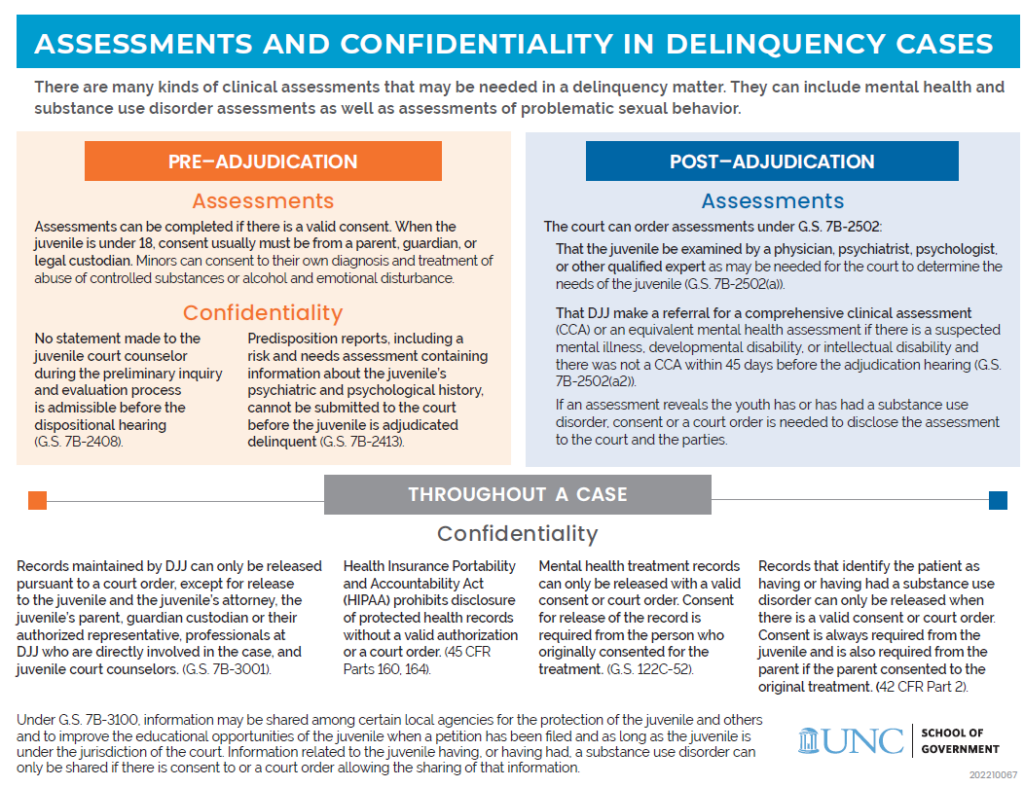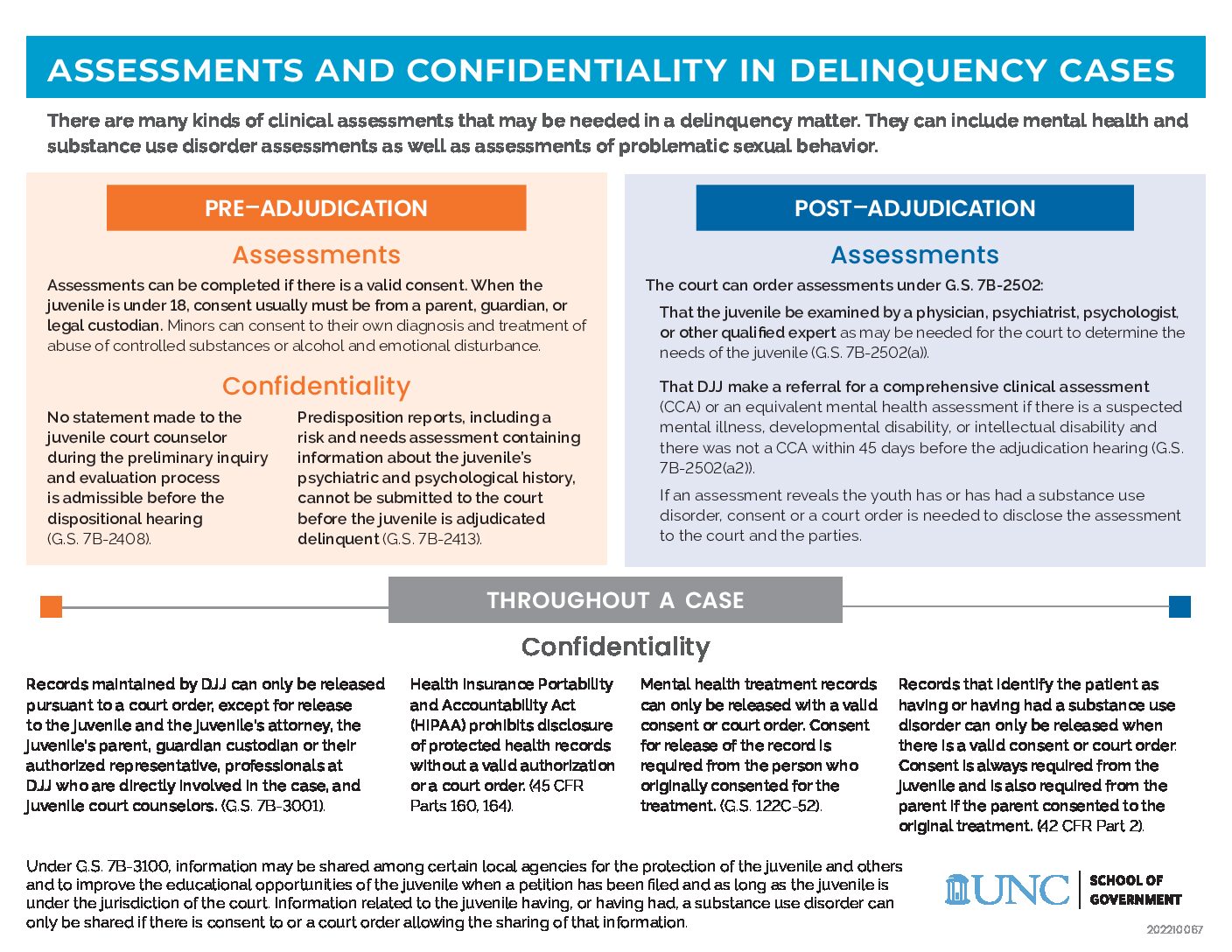When the court issues an order of disposition committing a juvenile to a youth development center (YDC), that commitment is almost always required to be for an indefinite period of time that lasts at least six months. G.S.7B-2513(a). The court cannot order an end date for these commitments. However, the court is required to determine the maximum period the juvenile may remain committed before an extension would have to be filed or the juvenile must be released, and to notify the juvenile of that determination at the time disposition is ordered. G.S.7B-2513(a4). How should this maximum period of commitment be calculated? And is every commitment eligible for an extension? This post addresses these questions.
juvenile justice
Addressing Substance Use Disorders Through Delinquency Dispositions
The Juvenile Code authorizes 14 different dispositional alternatives for delinquency cases that result in Level 1 dispositions and 23 different dispositional alternatives for delinquency cases that result in Level 2 dispositions. G.S. 7B-2508(c), (d); G.S. 7B-2506(1)-(23). For both Level I and Level 2 dispositions, cooperating with substance abuse treatment is a dispositional option. It can be challenging to sort through the many available dispositional alternatives to order an effective and individually tailored disposition that addresses the risks and needs of the juvenile. This blog addresses why it might be important to focus on substance use disorders as part of disposition, how to know when a juvenile needs substance use disorder treatment, and how substance use disorder treatment may be included as a dispositional alternative.
Statutory Changes Related to Juvenile Interrogation and Secure Custody Orders
This post covers recent statutory changes related to the custodial interrogation of youth who are 16 and 17 years of age and to the issuance and execution of secure custody orders in delinquency cases. All of these changes are contained in Session law 2023-114 and will apply to offenses committed on or after December 1, 2023.
Juvenile Code Does Not Authorize Transfer Based on Consent
One of the more common questions I receive about the transfer of a case from juvenile jurisdiction to the jurisdiction of the superior court for trial as an adult is whether transfer can be ordered based on consent of the juvenile. The issue seems to cross my desk when a juvenile has some charges pending in criminal court and there are unrelated felony charges pending under juvenile jurisdiction. The short answer is no. The statutory structure that governs transfer does not allow for ordering transfer based on consent. Why?
The Adolescent Brain and Mens Rea
Delinquency adjudications and criminal convictions of minors who have been transferred to Superior Court for trial as adults both require that the elements of the offense charged are proved beyond a reasonable doubt, including that the required criminal state of mind, or mens rea, existed. The adolescent mind has been the subject of substantial scientific research. This research grounded several United State Supreme Court decisions related to criminal punishment of minors and when Miranda warnings are necessary. However, the question of how the science of adolescent brain development does or does not connect to the mens rea requirements of various offenses is not well litigated. The North Carolina Court of Appeals dipped a toe in this area in its recent ruling in State v. Smith, __ N.C. App. __ (June 6, 2023).
Juveniles and the Law of Impaired Driving
What law applies when a juvenile is suspected of impaired driving? If the juvenile is 16- or 17-years-old, the criminal law applies in the same way that it applies to someone aged 18 or older. These offenses are carved out of juvenile jurisdiction (G.S. 7B-1501(7)b.) They are therefore criminal matters from their inception. However, if the juvenile is under age 16 at the time of the offense, the case is a juvenile matter from its inception. This blog explains how cases alleging impaired driving under the age of 16 should proceed pursuant to the Juvenile Code.
Nontestimonial Identification Orders in Delinquency Matters
The law that governs the use of nontestimonial identification procedures in delinquency matters is markedly different than the law that governs use of these same procedures in criminal matters. The Juvenile Code requires a court order prior to the use of most nontestimonial identification procedures, a nontestimonial identification order (NTO) can only be issued in relation to felony charges, there are specific statutes that govern the destruction of resulting records, and the willful violation of the juvenile NTO statutes carries a criminal penalty. This post describes when NTOs are needed, and the procedure that must be followed to obtain them, in matters under juvenile jurisdiction.
Assessments in Delinquency Cases: When Can They be Done and Are They Confidential?

One of the unique features of the juvenile justice system is its statutory focus on identifying the needs of juveniles and resolving matters to provide “appropriate rehabilitative services to juveniles.” G.S. 7B-1500(2)b. In addition to protecting public safety, dispositions should include “an appropriate plan to meet the needs of the juvenile.” G.S. 7B-2500. The caselaw and statutes that govern one form of assessment in delinquency cases—the comprehensive clinical assessment (CCA)—have undergone rapid change in the last few years. Other assessments, such as assessment for problematic sexual behavior or trauma-focused assessments, may also be needed in certain cases. Questions abound regarding when assessments can occur and what confidentiality law applies to them. This new infographic provides a high-level overview of the law that addresses these questions.
New Juvenile Law Bulletin on Juvenile Interrogation
What circumstances constitute custodial interrogation in a school setting? Who counts as a guardian or custodian for the purpose of a custodial interrogation of a juvenile? Under what circumstances can a juvenile waive their rights that attach during a custodial interrogation? A new Juvenile Law Bulletin on Juvenile Interrogation is now available as a School … Read more
Juveniles and Firearms: Recent Data Trends
The 2022 Annual Report from the North Carolina Child Fatality Task Force (CFTF) highlights a significant increase in firearm-related deaths among North Carolina’s youth. The CFTF Annual Report, submitted in May of 2022, details child fatalities that occurred in North Carolina in 2020. According to the CFTF, rates for suicides, homicides, and firearm deaths for children in North Carolina all increased in 2020. CFTF Annual Report, p. 2. Firearms were used in 12 of the 20 suicides reported among youth ages 10 – 14 and in 19 of the 35 suicides reported among youth ages 15 – 17. All 11 of the homicides reported against youth ages 10 – 14 involved a firearm and 48 of the 50 homicides reported against youth ages 15 – 17 involved a firearm. Table 1, CFTF Annual Report. Suicide was the leading cause of death among youth ages 10 – 14 and homicide was the leading cause of death among youth ages 15 – 17. Table 2, CFTF Annual Report.
These numbers reflect an increasing trend of firearm-related deaths among youth. While there were 525 firearm-related youth deaths between 2011 and 2020, 105 firearm-related youth deaths were recorded in 2020 alone. CFTF Annual Report, p. 18.
Is this trend rooted in more violent firearm usage by youth? The suicide data clearly reflects youth use of firearms to kill themselves. Do the homicide numbers reflect youth shooting other youth? Data from the Division of Juvenile Justice and Delinquency Prevention (DJJDP) may shed some light on that question.
